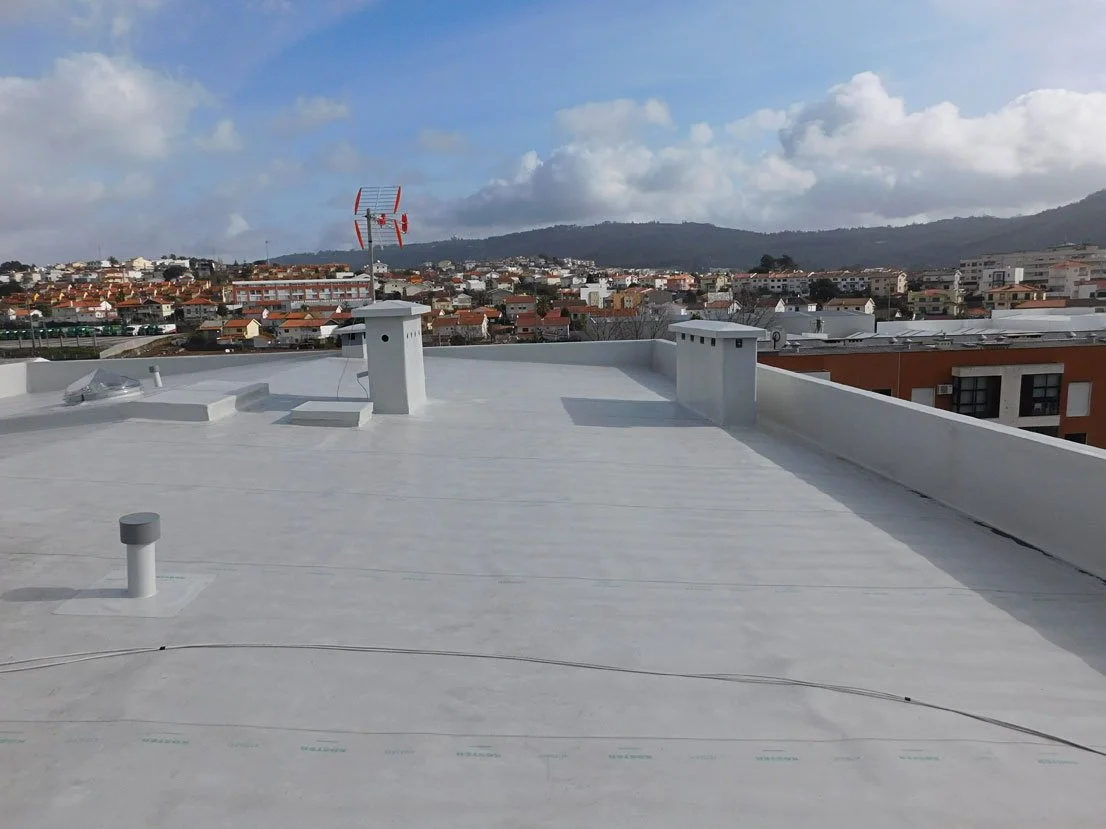
Renovation
Renovation
Before
After
Every roof surface in need of renovation can be waterproofed with a TPO roofing membrane from the KÖSTER TPO roofing membranes product range. If the wind loads can demonstrably be carried by the existing roof construction, then an adhered roofing system with KÖSTER TPO SK or KÖSTER TPO 2.0 F, glued with KÖSTER 2C PUR Membrane Adhesive is recommended. The existing substrate dictates which system can best be used.
-
Old Bitumen roof
KÖSTER roofing membranes are bitumen-compatible and can be installed directly on old bitumen roof waterproofing
If the positioning of the roof structure is stable, fleece-laminated KÖSTER TPO roofing membranes can be adhered with KÖSTER PUR Membrane Adhesive or KÖSTER 2C PUR Membrane Adhesive
Mechanical fastening of KÖSTER TPO roofing membranes is also possible. This option is adequate if the old waterproofing is no longer stable
Old Plastic roofs
KÖSTER roofing membranes can be installed directly on old rubber (EPDM) or plastic membranes (PVC or TPO)
KÖSTER roofing membranes can be installed directly on liquid membrane roofs (Polyurea, PU, MS, cementitious acrylics, etc) due to their material compatibility with all conventional waterproofing membranes
On all types of existing membranes, the different application techniques can be used: loose laid under ballast, mechanical fastening
A fire protection layer may be required
-
If the old roof waterproofing layer is no longer stable, if negative effects on the new waterproofing with KÖSTER membranes are to be expected, or if the insulation material is partially soaked through, this old layer must be removed
The KÖSTER waterproofing layers can be installed with different application technique like loose laid under ballast, mechanical fastening or bonded systems with KOSTER PUR adhesives or Koster TPO SK (FR) self adhesive TPO membrane
Moist insulation must always be replaced for new insulation
If KÖSTER TPO F / TPO SK roofing membranes are to be adhered to existing insulation, it must be fastened in a windproof manner
-
Flat roof renovation with additional insulation of a dry roof structure with a functional vapour seal can usually be without a detailed physical calculation or evaluation. The old waterproofing layer can be retained in this case
The requirements for stability of the roof layer package must be observed. The thickness of the additional insulation should be at least 5 cm, irrespective of the building structural assessment
For this type of renovation KOSTER provides a wide range of options from the mechanical fastening system to the loose laid under ballast, but also through it’s bonded systems with special KOSTER PUR adhesives or custom self-adhesive membrane
If there is dampness in the roof structure, renovation with additional insulation must be technically analyzed in detail, as the drying process takes many years and is determined by the thermal transfer resistance of the thermal insulation and especially by the diffusion resistance of the new waterproofing
Renovation of a damp roof structure without replacing the wet insulation should only be undertaken in exceptional cases!
The prerequisite is a functioning vapour seal, as otherwise the moisture from the insulating material can also seep inwards and cause damage to the building over a long period of time.
-
If damage to the roof structure is extensive and, for example, if the roof drainage or other built-in parts have to be renovated, it is more economical to carry out a complete renovation
All of the waterproofing and the thermal insulation layers are replaced during this type of renovation
Is there a vapour seal, or is it still functional?
Is the insulation dry and does it meet the requirements?
Are there any thermal bridges in the roof structure?
Is the roof layer package still stable with respect to wind suction forces, e.g. by sufficient adhesion, or have the mechanical fastening elements corroded?
The following points must also be checked:
Does the roof have a sufficient gradient?
Does the existing drainage system meet the requirements?
Are there enough emergency drains for internally draining roof surfaces?
Is the insulation thickness sufficient?
Is the load-bearing capacity of the roof structure still sufficient?
Are the junction heights sufficient?
Are there any movement joints?
Do built-in parts, such as downpipes or skylight domes, have to be replaced or supplemented?
A renovation plan can be prepared after evaluating all these points.






